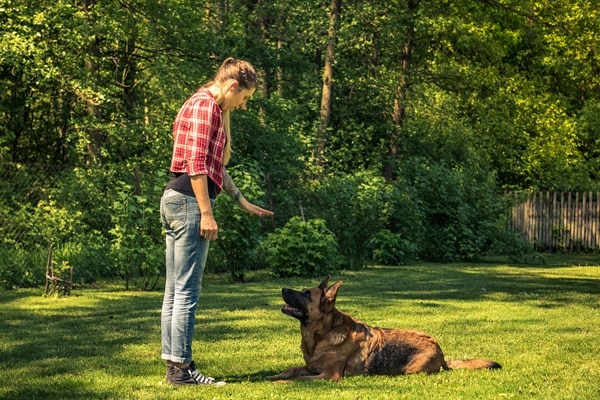Teaching your dog basic commands is not only a fundamental aspect of responsible pet ownership but also significantly enhances its safety and well-being. Commands like sit, stay, come, down, and leave are essential tools that every dog owner should use to manage their pet effectively in various situations. This training fosters a positive human-animal bond and helps maintain peace at home and in public. Moreover, obedience training can alleviate many common behavior problems and reduce the stress experienced by both the dog and the owner.
Sit Command – The Foundation Of Obedience Training

The “Sit” command is often one of the first commands taught because it is relatively easy for dogs to learn and serves as a building block for other commands. Training your dog to sit is crucial for controlling their movements and getting their attention in everyday situations. It is a foundation for teaching discipline and can calm your dog in exciting or overwhelming environments. By mastering this simple command, your dog learns to respond to your cues and begins understanding the basics of structured training.
Teaching the sit command starts with a simple technique: using a treat to guide the dog’s nose upwards, causing their bottom to naturally lower into a sitting position. Once seated, immediately reward them with the treat and vocal praise. Repetition is key; practice the sit command regularly in short, positive sessions. Consistency helps your dog associate the action with the command, reinforcing their training. Over time, this foundational skill will improve your dog’s obedience and enhance your ability to communicate with them effectively.
Stay Command – Teaching Patience And Self-Control

The “Stay” command is essential for teaching your dog self-control and patience, which are vital in many daily and safety-related scenarios. Whether it’s waiting at the door, not rushing out of the car, or simply staying put during family meals, the stay command comes in handy. It helps prevent potentially dangerous situations, such as running into the street and promotes a calm demeanor in your dog.
Start in a quiet environment with minimal distractions to teach your dog to stay. Ask your dog to sit or lie down, then introduce the stay command with a firm, clear voice and an extended hand signal, usually a flat hand facing the dog. Take a step back, and if your dog maintains the stay, reward them after a few seconds. Gradually increase the duration and distance of the stay, always returning to reward your dog. With patience and consistent training, your dog will learn to maintain the stay command until released, demonstrating their understanding and respect for your cues.
Come Command – Ensuring Your Dog’s Safety

The “Come” command is possibly the most crucial for safety. It enables you to recall your dog in potentially harmful situations. Whether off-leash in the park or accidentally out the front door, when your dog responds reliably to the command, it can literally be a lifesaver. This command is an integral part of any dog’s training regimen, ensuring they return to you despite distractions.
Training your dog to come involves making yourself the most exciting option. Start in a distraction-free area and use a happy, enthusiastic voice to call your dog to you. When they arrive, reward them with treats and affection, making the experience positive and rewarding. As they improve, they gradually introduce more distractions. Consistency in practice and reward will cement this behavior, making the command a reliable tool for managing your dog’s movements and ensuring their safety.
Down Command – Promoting Calm And Submission

The “Down” command is valuable for promoting calm behavior and submission in your dog. It reduces their level of excitement and helps them settle into various situations. This command is particularly helpful during visits to the vet, encounters with strangers, or when you need your dog to relax at home. Teaching down is about associating the action with calm and quiet times.
Start with your dog in the sit position to teach the down command. Hold a treat near their nose and slowly move it straight down to the ground between their paws, then away from them, encouraging their body to follow their head into a lying position. Once fully down, say “down,” give them the treat, and show affection. Repeating this sequence regularly helps your dog understand and respond to the down command promptly. This not only aids in managing their behavior but also in building a respectful relationship between you and your pet.
Leave It Command – Essential For Preventing Unwanted Behaviors

“Leave it” is a command that teaches dogs to ignore whatever they are interested in. It is essential for preventing unwanted behaviors such as chewing on inappropriate items or picking up dangerous objects. This command offers a straightforward way to communicate to your dog that something is off-limits, enhancing their safety and improving their impulse control.
Begin teaching the leave it command by holding a treat in your hand and letting your dog sniff but not eat it. Close your hand and say, “Leave it.” Wait for your dog to stop sniffing and even look away. Once they do, reward them with a different treat from your other hand. Practice this with different objects and gradually increase the difficulty of using more tempting items. As your dog masters this command, they learn to respect boundaries and follow your guidance, which is crucial in maintaining their safety and well-being.
Unleashing The Potential – A Well-Trained Dog Is A Happy Dog
Training your dog in these five essential commands does more than just improve their obedience; it enhances their overall happiness and safety. A well-trained dog is easier to manage, less anxious in unfamiliar situations, and more receptive to interactions with humans and other dogs. Regular training sessions also strengthen the bond between you and your dog, building a foundation of mutual respect and understanding. As you continue to reinforce these commands, you’ll notice a remarkable improvement in your dog’s behavior and a significant stress reduction for you and your pet. Remember, a well-trained dog is indeed a happy dog.